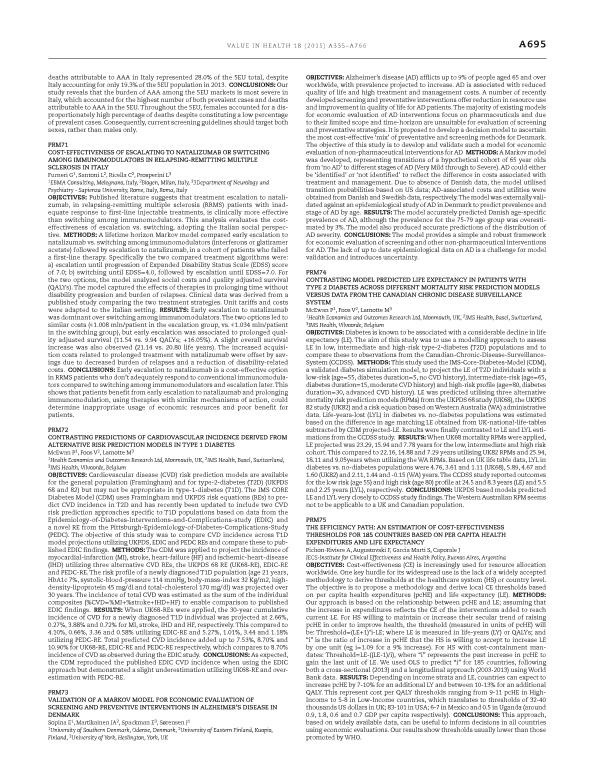Mostrar el registro sencillo del ítem
dc.contributor.author
Pichón-Riviere, Andrés

dc.contributor.author
Augustovski, Federico Ariel

dc.contributor.author
Garcia Marti, S
dc.contributor.author
Caporale, J
dc.date.available
2018-04-17T15:05:43Z
dc.date.issued
2015-11
dc.identifier.citation
Pichón-Riviere, Andrés; Augustovski, Federico Ariel; Garcia Marti, S; Caporale, J; The Efficiency Path: An Estimation of Cost-Effectiveness Thresholds for 185 Countries Based on Per Capita Health Expenditures and Life Expectancy; Wiley Blackwell Publishing, Inc; Value In Health; 18; 7; 11-2015; A695-A696
dc.identifier.issn
1098-3015
dc.identifier.uri
http://hdl.handle.net/11336/42262
dc.description.abstract
Objectives: Cost-effectiveness (CE) is increasingly used for resource allocationworldwide. One key hurdle for its widespread use is the lack of a widely acceptedmethodology to derive thresholds at the healthcare system (HS) or country level.The objective is to propose a methodology and derive local CE thresholds basedon per capita health expenditures (pcHE) and life expectancy (LE). Methods:Our approach is based on the relationship between pcHE and LE; assuming thatthe increase in expenditures reflects the CE of the interventions added to reachcurrent LE. For HS willing to maintain or increase their secular trend of raisingpcHE in order to improve health, the threshold (measured in units of pcHE) willbe: Threshold=(LE+1)*i-LE; where LE is measured in life-years (LY) or QALYs; and?i? is the ratio of increase in pcHE that the HS is willing to accept to increase LEby one unit (eg i=1.09 for a 9% increase). For HS with cost-containment mandates:Threshold=LE-((LE-1)/i), where ?i? represents the past increase in pcHE togain the last unit of LE. We used OLS to predict ?i? for 185 countries, followingboth a cross-sectional (2013) and a longitudinal approach (2003-2013) using WorldBank data. Results: Depending on income strata and LE, countries can expect toincrease pcHE by 7-10% for an additional LY and between 10-13% for an additionalQALY. This represent cost per QALY thresholds ranging from 9-11 pcHE in HighIncometo 5-8 in Low-Income countries, which translates to thresholds of 32-40thousands US dollars in UK; 83-101 in USA; 6-7 in Mexico and 0.5 in Uganda (around0.9, 1.8, 0.6 and 0.7 GDP per capita respectively). Conclusions: This approach,based on widely available data, can be useful to inform decisions in all countriesusing economic evaluations. Our results show thresholds usually lower than thosepromoted by WHO
dc.format
application/pdf
dc.language.iso
eng
dc.publisher
Wiley Blackwell Publishing, Inc

dc.rights
info:eu-repo/semantics/openAccess
dc.rights.uri
https://creativecommons.org/licenses/by-nc-sa/2.5/ar/
dc.subject
Cost-Efectiveness
dc.subject.classification
Medicina Critica y de Emergencia

dc.subject.classification
Medicina Clínica

dc.subject.classification
CIENCIAS MÉDICAS Y DE LA SALUD

dc.title
The Efficiency Path: An Estimation of Cost-Effectiveness Thresholds for 185 Countries Based on Per Capita Health Expenditures and Life Expectancy
dc.type
info:eu-repo/semantics/article
dc.type
info:ar-repo/semantics/artículo
dc.type
info:eu-repo/semantics/publishedVersion
dc.date.updated
2018-04-17T13:51:56Z
dc.journal.volume
18
dc.journal.number
7
dc.journal.pagination
A695-A696
dc.journal.pais
Reino Unido

dc.journal.ciudad
Londres
dc.description.fil
Fil: Pichón-Riviere, Andrés. Instituto de Efectividad Clínica y Sanitaria; Argentina
dc.description.fil
Fil: Augustovski, Federico Ariel. Consejo Nacional de Investigaciones Científicas y Técnicas; Argentina. Instituto de Efectividad Clínica y Sanitaria; Argentina
dc.description.fil
Fil: Garcia Marti, S. Instituto de Efectividad Clínica y Sanitaria; Argentina
dc.description.fil
Fil: Caporale, J. Instituto de Efectividad Clínica y Sanitaria; Argentina
dc.journal.title
Value In Health

dc.relation.alternativeid
info:eu-repo/semantics/altIdentifier/doi/http://dx.doi.org/10.1016/j.jval.2015.09.2592
dc.relation.alternativeid
info:eu-repo/semantics/altIdentifier/url/https://www.sciencedirect.com/science/article/pii/S1098301515046689
Archivos asociados
